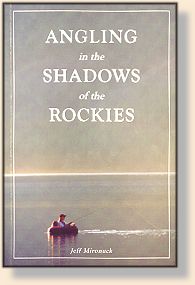Where To Start Fly Fishing
When Away From Home - Part 3
By Gerry Frederick
The Flies
The flies you choose are up to you. If you have experience fly fishing in the
Rockies you may already have a comprehensive fly selection to start with.
Every experienced fly fisher of course has his or her favorite fly patterns.
These are usually flies that they have a good history with and have learned
how to fish. Have confidence in the flies you choose. Don't add too many
unfamilair flies to your box too quickly. Learn what each fly imitates and how
to fish it; what depth and speed it should have in the water.
The Pheasant Tail Nymph and other popular common nymphs like stone's and
caddis nymphs catch trout all the time. Trust them, they work all over the
world. In the waters of the Rocky Mountains these flies and a few more old
standbys will catch fish if the fish are there and the fly is presented the way
they want it.
Here are my fly suggestions. I feel these few flies in a variety of colors and
sizes make up a great selection. Six flies in four sizes made up in three colors
offer the fly fisher 72 flies, a good place to start.
- Pheasant Trial (with or without Beadhead) sizes 10 -18
- Hares Ear (with or without Beadhead) sizes 10 - 18
- Beadhead Prince - sizes 8 - 16
- Heavy Stone (Black, tan, olive, yellow) sizes 4 - 10
- Latex Caddis (Tan, olive, rusty brown) sizes 8 - 14
- Chironomid (Black, green, brown, red) sizes 10 - 18
Remember to keep it simple. Make it easy on yourself and easy on the
fish. Trout, certainly Rocky Mountain trout, are not as picky as you may
think. All trout are opportunistic feeders. They will feed on what ever
looks and acts like food. Sure enough they have their picky periods.
That's when we need to get serious. Stay with the fundamentals and
fish the flies in the box properly. Look forward to those challenging
days. Beginners will have more than their share of picky fish. Conquering
tough days on the water is very rewarding. More so when fishing away
from home. A good days fly fishing in new waters, perhaps using a
different technique or fly only adds to the life experience. Fishing
abilities can only grow with experience.
Other chapters in this book will help with more details and suggestions.
Fly fishing offers a large array of methods and gear. After a good
fundamental start it is fun to try something new. Once the fly fisher
has a good understanding of nymph fishing the natural progression is
to dry fly. Top water is fun, some fly fishers believe it's the only way
to go. The truth is it's not always the most productive.

It is widely believed that trout feed under the surface 80% or more of the
time. That's why nymphs are a good place to start. They are also a lot
easier to fish and learn. Trout are a little more willing and less selective
under the surface. Cutthroat trout are the most gullible of all, and the
Rockies are full of them. If you're lucky enough to fly fish the Rockies
you'll learn quickly what works. Get prepared, steal all the hot information
you can and remeber to K.I.S.S. Keep It Simple Stupid. You'll have
a great time and whatever your level of experience you'll learn something.
~ Gerry Frederick
Credits: From Angling in the Shadows of the Rockies
by Jeff Mironuck. We thank
Frank Amato Publications, Inc. for use permission!
Our Man In Canada Archives
|



